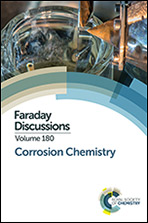The corrosion protection of AA2024-T3 aluminium alloy by leaching of lithium-containing salts from organic coatings
Abstract
Lithium carbonate and lithium oxalate were incorporated as leachable corrosion inhibitors in model organic coatings for the protection of AA2024-T3. The coated samples were artificially damaged with a scribe. It was found that the lithium-salts are able to leach from the organic coating and form a protective layer in the scribe on AA2024-T3 under neutral salt spray conditions. The present paper shows the first observation and analysis of these corrosion protective layers, generated from lithium-salt loaded organic coatings. The scribed areas were examined by scanning and transmission electron microscopy before and after neutral salt spray exposure (ASTM-B117). The protective layers typically consist of three different layered regions, including a relatively dense layer near the alloy substrate, a porous middle layer and a flake-shaped outer layer, with lithium uniformly distributed throughout all three layers. Scanning electron microscopy and white light interferometry surface roughness measurements demonstrate that the formation of the layer occurs rapidly and, therefore provides an effective inhibition mechanism. Based on the observation of this work, a mechanism is proposed for the formation of these protective layers.
- This article is part of the themed collection: Corrosion Chemistry

 Please wait while we load your content...
Please wait while we load your content...